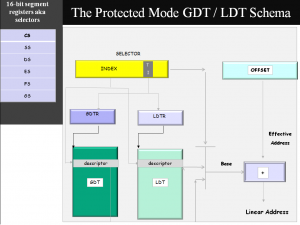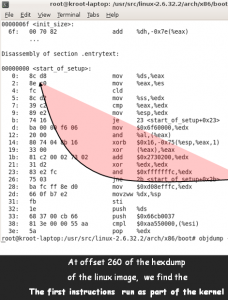OK… I am talking about my friend Carlos Santana, and also about the difference between x86 Intel Real Mode Addressing and Protected Mode Addressing.
We will hit it up with Carlos later on in this blog. But business first for now, shall we ?
We would like to eventually explore just why .. oh why … Real Mode is limited to 1MB Memory.

And while doing so, also understand x86 “Protected Mode” addressing. We start with an x86 assembly instruction (AT&T syntax, because that is what the Linux Kernel uses), and illustrate address formation at the most important fundamental levels:
movl (%ebp), %eax
Let us look at Protected Mode Address formation first:
In this instruction shown above, We use ebp to form the “effective” address (ebp IS the “effective” address), then we add the “base” from the (default) segment register (DS) to the “effective address” to come up with the “linear address”. Which will be used to look up the TLB to translate into a Physical Address (if Paging is enabled), or the Linear Address becomes the Physical Address if Paging is NOT enabled.
The “Selector” shown IS the value of the “Selector” component of the Segment Register “DS” (Each Segment register has a “Selector” component). In Protected mode, the 3rd-most lsb of the “Selector” is called the “TI” / Table Indicator. It is use to select one of two tables (GDT or the LDT), bits (31:3) then index into the GDT or the LDT, and we come with a 8-byte “Segment Descriptor”.
That “Segment Descriptor” we just came up with has a 32-bit “Base”, which will be added to the Effective Address (which in our assembly instruction, is the value of General Purpose Register EBP), and the net result becomes the Linear Address. And that Linear Address either goes through the Paging Translation to determine Physical Mmeory Address (If Paging IS enabled)…. or IS the Physical Address if Paging Mode is NOT enabled (as determined by the CR0.PG bit)
All of the above applies to x86 Protected Mode. How about “Real Mode” which does not have Descriptors etc or even Paging Mode ?
Well, the Selector (DS) and Register Sizes sizes (ebp) can only be 16 bits in real mode. The “Base” of the descriptor is replaced by the Selector Left-Shifted by 4 (* 16), and that is added to the effective address (bp).
Note that this implies that Linear Address is
And we have just corroborated 60 minutes that x86 Real Mode is limited to 1MB Memory addressing.
Ofcourse Carlos, x86 has now gone to Infinity and Beyond with Huge Pages and 48-bit Linear Addressing. And the Implications are huge also with moving beyond the measly (and respected) 4K Page sizes to 2M/4M/1G Page sizes. We have a blog below on this, and more coming.
As well as with some other key areas, Memory Management plays a key and consuming role in Optimizing for Multiprocessing / Multicore and Multithreaded execution models.
There is no substitute in this regard for our Course Advanced Kernel memory Management. Hit us up on it.
We explain these specific x86 features, Linux Kernel concepts and more in detail in my classes ( Advanced Linux Kernel Programming @UCSC-Extension), and also in other classes that I teach independently. Please take note, and take advantage also, of upcoming training sessions. As always, Feedback, Questions and Comments are appreciated and will be responded to. Cheers !
Take it away Carlos Santana !



Recent Comments